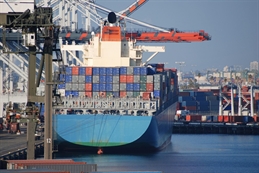
January throughput numbers for U.S. container ports show declining volumes across the board, but the West Coast ports fared significantly worse than their counterparts on the East Coast and the Gulf of Mexico, reflecting the shift of Asian imports away from the western gateways.
Concerns are growing that these diversions, which have been attributed to cargo owners’ concerns about congestion and possible port strikes on the West Coast, could prove permanent.
Containerized import volumes at the Top 10 U.S. box ports tumbled 17.9% in January from a year earlier, according to the monthly container volume report from McCown. The decline reflects the sharp drop in U.S. imports as demand has waned and inventory levels remain high.
However, there is a marked difference in the fortunes of West Coast ports and the big U.S. gateways elsewhere. Whereas the import volumes of the former fell 23.5%, the slowdown at East Coast and Gulf ports was 12.6%, McCown reported. The port of Long Beach had the worst tally, showing a drop of 32.3%.
Overall, Long Beach handled 573,772 TEUs, down 28.4% from its record-setting tally in January 2022. At the neighboring port of Los Angeles, total box traffic sank 16% year-on-year.
On the opposite coast the port of Savannah handled 11.5% less container traffic in January, while Houston saw its TEU count shrink 1%. Both ports had seen strong growth last year, although Savannah’s flows were hampered by a build-up of ships waiting for berth space. By September Houston’s box volume had risen 26% year-on-year.
A sizeable chunk of the growth in the east and on the Gulf coast has been attributed to diversions of Asian imports away from the West Coast gateways.
Cargo owners were worried about a possible repeat of the congestion that slowed imports through the California ports in 2021, and additional concern arose from the labor contract negotiations on the West Coast. The previous round in 2014/15 had sparked shutdowns that took a heavy toll on import flows.
Mindful of these concerns the Pacific Maritime Association, which represents the terminals on the West Coast, and the International Longshore & Warehouse Union pledged to refrain from disruption, but the negotiations have dragged on well beyond the July 1 expiry date of the old contract and got bogged down in a jurisdictional dispute at the port of Seattle for several months.
Cargo owners are worried by the long delay. Peter Friedman, executive director of the Agriculture Transportation Coalition, declared in early February that he regarded the impasse as worse than the serious but relatively short-lived disruption of a work stoppage.
Faced with uncertainty how much longer it will take the two sides to come to an agreement, shippers find they are running out of time to make strategic decisions that have long-term consequences, such as where to locate new distribution or transload facilities, he warned.
“With this thing lasting on and on, permanent decisions are being made that are irreversible and those are real estate decisions,” he said.
Others share his view that some of the cargo that was diverted from the West Coast won’t return after the contract negotiations are sealed. Brian Harold, managing director of APM Terminals Mobile, thinks that much of the freight that was shifted to Mobile and contributed to the port’s double-digit rise in volume will not shift back to California.
By some estimates, the West Coast ports will lose more than 10% of the freight that was diverted for good.
On the other hand, some cargo owners have already switched back to California, reported a spokesman for AIT Worldwide Logistics. Those shifted flows to East Coast ports to avoid the congestion that snared up imports in 2021. With congestion, transit times and drayage, they no longer an issue, and as a result, they have reverted to their original routings.
An executive of a drayage firm remarked that the ocean carrier rates, vessel availability and transit times through the West Coast are too attractive for importers bringing in goods from east Asia.
Gene Seroka, executive director of the port of Los Angeles, commented that the shift of Asian imports to ports on the Eastern Seaboard and the Gulf is not a new phenomenon and that the causes for this extend beyond the labor and congestion issues. Cargo owners have mentioned multiple issues, including higher costs and restrictive regulations in California, he said, adding that the West Coast ports have not been able to attract as much federal funding over the past decade as their counterparts in the east.
Another factor that has slowed traffic through the West Coast has been congestion on the rail network. Both Class I railroads that serve the coast – BNSF and Union Pacific (UP) – resorted to metering traffic from the coast because of clogged-up inland terminals. UP management was summoned to Washington by the Transportation Safety Board in December for hearings about its excessive use of embargoes and low performance.
Mario Cordero, executive director of the port of Long Beach, is not fazed.
“I remain optimistic that we will recapture market share and develop projects that will enhance our long-term growth, sustainable operations and the reliable movement of goods through the Port of Long Beach,” he said.
Still, the competition in the east is growing, as ports like Savannah invest in further upgrades.
New Orleans is on course to see two container terminals built. Ports America, the largest container terminal operator in the US, and Mediterranean Shipping have pledged to contribute US$800 million to a US$1.8 billion container facility project at the port with a planned capacity of 2 million TEU. Construction is supposed to kick off in 2025, with the first berth due to open in 2028.
Just three miles away a consortium of private developers, Plaquemines port and APM Terminals, intends to build a container facility.
By Ian Putzger
Correspondent | Toronto



